
James Watt was a Scottish inventor, mechanical engineer, and chemist who improved on Thomas Newcomen's 1712 Newcomen steam engine with his Watt steam engine in 1776, which was fundamental to the changes brought by the Industrial Revolution in both his native Great Britain and the rest of the world.

The Lunar Society of Birmingham was a British dinner club and informal learned society of prominent figures in the Midlands Enlightenment, including industrialists, natural philosophers and intellectuals, who met regularly between 1765 and 1813 in Birmingham. At first called the Lunar Circle, "Lunar Society" became the formal name by 1775. The name arose because the society would meet during the full moon, as the extra light made the journey home easier and safer in the absence of street lighting. The members cheerfully referred to themselves as "lunaticks", a contemporary spelling of lunatics. Venues included Erasmus Darwin's home in Lichfield, Matthew Boulton's home, Soho House, Bowbridge House in Derbyshire, and Great Barr Hall.

Matthew Boulton was an English businessman, inventor, mechanical engineer, and silversmith. He was a business partner of the Scottish engineer James Watt. In the final quarter of the 18th century, the partnership installed hundreds of Boulton & Watt steam engines, which were a great advance on the state of the art, making possible the mechanisation of factories and mills. Boulton applied modern techniques to the minting of coins, striking millions of pieces for Britain and other countries, and supplying the Royal Mint with up-to-date equipment.

James Keir FRS was a Scottish chemist, geologist, industrialist, and inventor, and an important member of the Lunar Society of Birmingham.
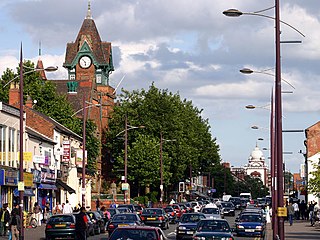
Handsworth is an inner-city area of Birmingham in the county of the West Midlands, England. Historically in Staffordshire, Handsworth lies just outside Birmingham City Centre and near the town of Smethwick. In 2021 the ward had a population of 11,820.
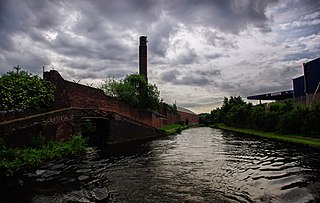
Soho is an area split between the Birmingham and Sandwell metropolitan boroughs of the West Midlands in England. The area is located on the A41 road. The name is an abbreviation of South House, denoting that it was located to the south of Handsworth. The section of the A41 separating Handsworth from Winson Green is known as Soho Road.
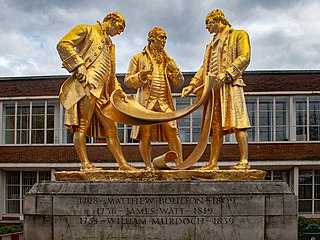
Boulton & Watt was an early British engineering and manufacturing firm in the business of designing and making marine and stationary steam engines. Founded in the English West Midlands around Birmingham in 1775 as a partnership between the English manufacturer Matthew Boulton and the Scottish engineer James Watt, the firm had a major role in the Industrial Revolution and grew to be a major producer of steam engines in the 19th century.

The Soho Manufactory was an early factory which pioneered mass production on the assembly line principle, in Soho, Birmingham, England, at the beginning of the Industrial Revolution. It operated from 1766–1848 and was demolished in 1853.
The toy industry in Birmingham was an economic sector that produced small goods in any material. Edmund Burke described Birmingham in Parliament in 1777 as "the great Toy Shop of Europe".
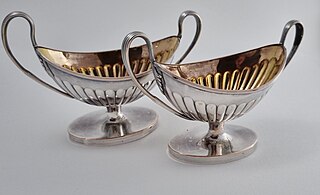
Old Sheffield Plate is the name generally given to the material developed by Thomas Boulsover in the 1740s, a fusion of copper and sterling silver which could be made into a range of items normally made in solid silver. The material rapidly gained popularity as a substitute for solid silver, as it was much cheaper to produce. Any object made in silver could in effect be made in Old Sheffield Plate, although objects subject to heavy wear such as spoons and forks were not so satisfactory in plate.
John Fothergill (1730–1782) was a merchant from Birmingham, England.

St Mary's Church, Handsworth, also known as Handsworth Old Church, is a Grade II* listed Anglican church in Handsworth, Birmingham, England. Its ten-acre (4 hectare) grounds are contiguous with Handsworth Park. It lies just off the Birmingham Outer Circle, and south of a cutting housing the site of the former Handsworth Wood railway station. It is noteworthy as the resting place of famous progenitors of the industrial age, and has been described as the "Cathedral of the Industrial Revolution".
Samuel Wyatt was an English architect and engineer. A member of the Wyatt family, which included several notable 18th- and 19th-century English architects, his work was primarily in a neoclassical style.
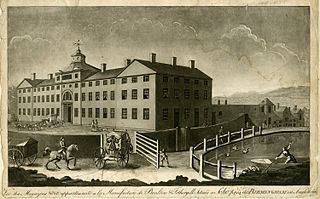
Soho Mint was created by Matthew Boulton in 1788 in his Soho Manufactory in Handsworth, West Midlands, England. A mint was erected at the manufactory containing eight machines, to his own patent design, driven by steam engine, each capable of striking 70 to 85 coins per minute.

The Midlands Enlightenment, also known as the West Midlands Enlightenment or the Birmingham Enlightenment, was a scientific, economic, political, cultural and legal manifestation of the Age of Enlightenment that developed in Birmingham and the wider English Midlands during the second half of the eighteenth century.

Francis Eginton (1737–1805), sometimes spelled Egginton, was an English glass painter. He painted windows for cathedrals, churches, chapels and stately homes, etc., around the country, leaving 50 large works altogether; his work was also exported abroad. His masterpiece is The Conversion of St. Paul, for the east window of St Paul's Church, Birmingham. He also developed a method for reproducing paintings mechanically.

Old Bess is an early beam engine built by the partnership of Boulton and Watt. The engine was constructed in 1777 and worked until 1848.

Conrad Heinrich Küchler was a German medalist who from 1793 until his death worked as a designer of coinage and medals for the manufacturer and mint owner Matthew Boulton.

Jean-Pierre Droz was a coin and medal engraver born in Switzerland and trained in Paris. Droz was most known for engraving the Napoléon coin at the Paris Mint.

Heathfield Hall was a house in Handsworth, Staffordshire, England, built for the engineer James Watt.




















